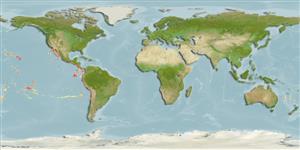Elasmobranchi (squali e razze) (sharks and rays) >
Squaliformes (Sleeper and dogfish sharks) >
Etmopteridae (Lantern sharks)
Etymology: Centroscyllium: Greek, kentron = sting + Greek, skylla = a kind of shark (Ref. 45335).
More on author: Garman.
Environment: milieu / climate zone / distribuzione batimetrica / distribution range
Ecologia
marino benthopelagico; distribuzione batimetrica 269 - 1170 m (Ref. 96339). Deep-water; 32°N - 30°S
Eastern Pacific: Hawaiian Islands, southern California (USA), Panama, Cocos Island (Costa Rica), Colombia, Ecuador, northern and central Chile, and the Galapagos Islands. Has been confused with Etmopterus granulosus (Günther, 1880) and Centroscyllium granulatum (Günther, 1887), but is quite distinct.
Size / Peso / Age
Maturità: Lm ? range ? - ? cm
Max length : 51.0 cm TL maschio/sesso non determinato; (Ref. 96339)
A little-known deepwater dogfish found on the continental and insular slopes. Incidentally caught in sablefish (Anoplopoma) traps but not utilized. Feeds chiefly on other fishes and invertebrates (Ref. 28023). Ovoviviparous (Ref. 205).
Life cycle and mating behavior
Maturità | Riproduzione | Deposizione | Uova | Fecundity | Larve
Distinct pairing with embrace (Ref. 205).
Compagno, L.J.V., 1984. FAO Species Catalogue. Vol. 4. Sharks of the world. An annotated and illustrated catalogue of shark species known to date. Part 1 - Hexanchiformes to Lamniformes. FAO Fish. Synop. 125(4/1):1-249. Rome, FAO. (Ref. 247)
IUCN Red List Status (Ref. 130435: Version 2025-1)
Threat to humans
Harmless
Human uses
Pesca: di nessun interesse
Strumenti
Special reports
Download XML
Fonti Internet
Estimates based on models
Preferred temperature (Fonte Biblio.
123201): 6.6 - 9.9, mean 8 °C (based on 44 cells).
Phylogenetic diversity index (Fonte Biblio.
82804): PD
50 = 0.5078 [Uniqueness, from 0.5 = low to 2.0 = high].
Bayesian length-weight: a=0.00372 (0.00188 - 0.00734), b=3.10 (2.92 - 3.28), in cm total length, based on LWR estimates for this (Sub)family-body shape (Ref.
93245).
Trophic level (Fonte Biblio.
69278): 3.9 ±0.56 se; based on food items.
Resilienza (Fonte Biblio.
120179): Basso, tempo minimo di raddoppiamento della popolazione 4.5 - 14 anni (Fec assumed to be <100).
Fishing Vulnerability (Ref.
59153): Moderate vulnerability (40 of 100).
🛈
Nutrients (Ref.
124155): Calcium = 6.46 [1.11, 35.03] mg/100g; Iron = 0.217 [0.049, 0.765] mg/100g; Protein = 17.3 [15.0, 20.0] %; Omega3 = 0.292 [0.094, 0.949] g/100g; Selenium = 15.5 [3.7, 55.0] μg/100g; VitaminA = 23.9 [3.9, 143.4] μg/100g; Zinc = 0.503 [0.225, 1.077] mg/100g (wet weight);
